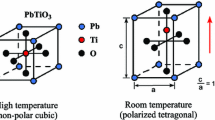Abstract
Mode I steady crack growth was analyzed to determine the toughening due to domain switching in ferroelectric ceramics. A multi-axial, electromechanically coupled, incremental constitutive theory is applied to model the material behavior of the ferroelectric ceramic. The constitutive law is then implemented within the finite element method to study steady crack growth. The effects of mechanical and electrical poling on the fracture toughness are investigated. Results for the predicted fracture toughness, remanent strain distributions, and domain switching zone shapes and sizes are presented. Finally, the model predictions are discussed in comparison discrete switching models and to experimental observations.
Similar content being viewed by others
References
G.G. Pisarenko, V.M. Chusko and S.P. Kovalev: Anisotropy of fracture toughness of piezoelectric ceramics. J. Am. Ceram. Soc. 68, 259 (1985).
K. Metha and A.V. Virkar: Fracture mechanisms in ferroelectric-ferroelastic lead zirconate titanate (Zr:Ti = 0.54:0.46) ceramics. J. Am. Ceram. Soc. 73, 567 (1990).
A.G. Tobin and Y.E. Pak: Effect of electric fields on fracture behavior of PZT ceramics. Proc. SPIE 1916, 78 (1993).
H. Wang and R.N. Singh: Crack propagation in piezoelectric ceramics: Effects of applied electric field. J. Appl. Phys. 81, 7471 (1997).
G.A. Schneider and V. Heyer: Influence of the electric field on Vickers indentation crack growth in BaTiO3. J. Eur. Ceram. Soc. 19, 1299 (1999).
S.L. Lucato, J. Lindner, D.C. Lupascu and J. Rödel: Influence of electrical and geometrical boundary conditions on crack growth in PZT. Key Eng. Mater. 206–213, 609 (2002).
W. Yang, F. Fang and M. Tao: Critical role of domain switching on the fracture toughness of poled ferroelectrics. Int. J. Solids Struct. 38, 2203 (2001).
S. Hackemann and W. Pfeiffer: Domain switching in process zones of PZT: Characterization by micro diffraction and fracture mechanical methods. J. Eur. Ceram. Soc. 23, 141 (2003).
M. Kamlah: Ferroelectric and ferroelastic piezoceramics—modeling and electromechanical hysteresis phenomena. Continuum Mech. Thermodyn. 13, 219 (2001).
C.M. Landis: Non-linear constitutive modeling of ferroelectrics. Curr. Opin. Solid State Mater. Sci. 8, 59 (2004).
C.M. Landis: Fully coupled, multi-axial, symmetric constitutive laws for polycrystalline ferroelectric ceramics. J. Mech. Phys. Solids 50, 127 (2002).
C.M. Landis: On the strain saturation conditions for polycrystalline ferroelastic materials. J. Appl. Mech. 70, 470 (2003).
C.M. Landis, J. Wang and J. Sheng: Micro-electromechanical determination of the possible remanent strain and polarization states in polycrystalline ferroelectrics and implications for phenomenological constitutive theories. J. Intell. Mater. Syst. Struct. 15, 513 (2004).
J.E. Huber, N.A. Fleck, C.M. Landis and R.M. McMeeking: A constitutive model for ferroelectric polycrystals. J. Mech. Phys. Solids 47, 1663 (1999).
C.S. Lynch: The effect of uniaxial stress on the electro-mechanical response of 8/65/35 PLZT. Acta Mater. 44, 4137 (1996).
C.M. Landis: On the fracture toughness of ferroelastic materials. J. Mech. Phys. Solids 51, 1347 (2003).
C.M. Landis: On the fracture toughness anisotropy of mechanically poled ferroelectric ceramics. Int. J. Fract. 126, 1 (2004).
J. Wang and C.M. Landis: On the fracture toughness of ferroelectric ceramics with electric field applied parallel to the crack front. Acta Mater. 52, 3435 (2004).
C.M. Landis: In-plane complex potentials for a special class of materials with degenerate piezoelectric properties. Int. J. Solids Struct. 41, 695 (2004).
J.W. Hutchinson “A course on nonlinear fracture mechanics,” Harvard University Report, DEAP S-8, Division of Applied Sciences (Harvard University, Cambridge, MA, 1974).
C.M. Landis: A new finite-element formulation for electromechanical boundary value problems. Int. J. Numer. Meth. Eng. 55, 613 (2002).
F.Z. Li, C.F. Shih and A. Needleman: Comparison of methods for calculating energy release rates. Eng. Fract. Mech. 21, 405 (1985).
C.M. Landis: Energetically consistent boundary conditions for electromechanical fracture. Int. J. Solids Struct. 41, 6291 (2004).
Author information
Authors and Affiliations
Corresponding author
Additional information
Address all correspondence to this author.
This paper was selected as the Outstanding Meeting Paper for the 2005 MRS Spring Meeting Symposium CC Proceedings, Vol. 881E.
Rights and permissions
About this article
Cite this article
Wang, J., Landis, C.M. Domain switch toughening in polycrystalline ferroelectrics. Journal of Materials Research 21, 13–20 (2006). https://doi.org/10.1557/jmr.2006.0002
Received:
Accepted:
Published:
Issue Date:
DOI: https://doi.org/10.1557/jmr.2006.0002




